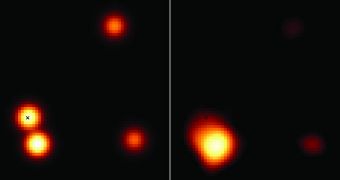A collaboration of astronomers announces the creation of a series of maps that detail the distribution of dark matter throughout some of the largest galaxies in the known Universe. The elusive stuff cannot be detected directly, but its presence can be inferred from its gravitational pull on normal matter.
With the new maps, the investigators were able to determine where most of the stuff is located inside each of the target galaxies, and also how much of it exists in each of the cosmic structures.
Dark matter is believed to make up a considerable portion of the Universe, even if astrophysicists have thus far been unable to detect it. A large number of detectors have been constructed around the world to see it, and the general view among scientists is that they are getting closer.
Even if the particles making up this form of matter cannot be detect directly, the gravitational effects that dark matter has on regular matter can be accurately measured, and theories could be derived to match those results.
In the new study, all the maps were produced from data astronomers collected while looking at how the large, massive galaxies bent light emitted by objects located even farther behind them.
The effect is called gravitational lensing, because the gravitational pull of galaxies located between telescopes and their target objects force light to get bent. This makes the galaxies act like giant lenses.
“We don't know very much about [dark matter] at all. To get any new information on dark matter, new information of any kind, is exciting,” said Eureka Scientific, Inc. expert David Pooley.
The scientist, who was also the lead author of the new study, presented the results on January 13 in Seattle, at the 217th winter meeting of the American Astronomical Society (AAS 2011).
He explains that the research focused on 14 massive elliptical galaxies, located at an average distance of about 6 billion light-years from Earth. Behind each of these objects lies another massive galaxies, but located about three times farther away .
“These types of systems are relatively rare. It takes a special configuration,” Pooley explains. His team used the NASA Chandra X-ray Observatory to make the measurements.
Observing the distant galaxies allowed the researchers to determine the distribution of dark matter in the gravitational lenses. They say that future investigations are bound to allow them to refine the maps even further, Space reports.
This could come in very hand for physicists trying to develop methods of discovering and analyzing dark matter directly. Any refinement in data of what the stuff might actually look like could be of tremendous use.

 14 DAY TRIAL //
14 DAY TRIAL //